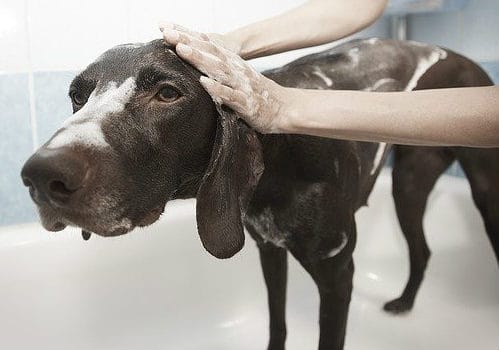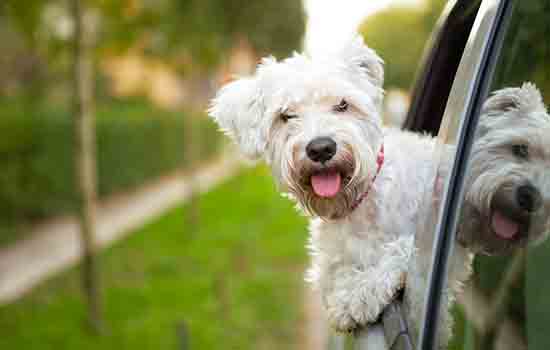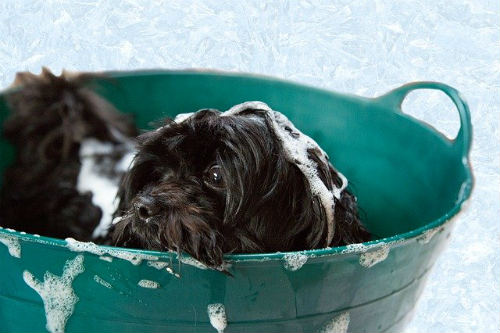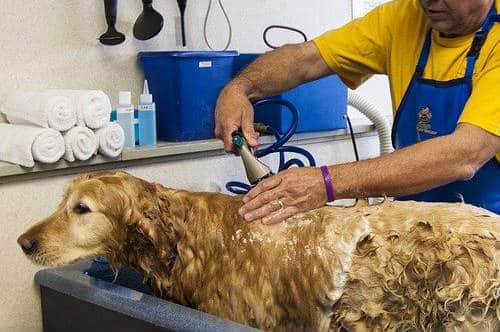Does your dog have a tendency to go into hiding when it hears the bath being run? Even dogs who are considered to be waterdogs may run away when it’s bathtime. Why do dogs hate baths? This article will endeavor to answer that question as well as offer solutions to make bathtime easier for your dog.
1. Lots of Touching

Most pet owners are confused when their dogs are avid swimmers in the lake or swimming pool but show an aversion towards bathtime. The reason may not have to do with the actual presence of water. Rather, it may be because of what else is involved during bathtime.
When your dog is swimming in the pool or lake, they’re able to swim at their leisure. It’s a freeing sensation. They’re able to go where they please. The act of swimming also comes naturally to most canines.
For bathtime, however, the area is far more enclosed than a swimming pool or a lake. They’re also unable to move freely. As its owner, you’re holding them still while you wash them. You’re essentially providing a lot of contact with the dog when it might not want it.
While it may be easy to think that a dog always desires petting and handling, this isn’t the case. Just like humans, dogs also have moments when they don’t want to be touched or messed with. The kind of handling that’s required for bathtime may be something that they don’t enjoy.
2. Slippery Floors
Another reason that dogs don’t particularly enjoy baths is because of the bathtub floor. It’s often too slippery and doesn’t offer them a lot of friction to hold themselves upright. Just like humans, they’re not too fond of the idea of slipping and falling.
Luckily, this can be an easy fix. One of the solutions that you can utilize in this instance is to place a mat on the bathtub floor. This can sometimes create enough friction for the dog to stick their claws into it and remain standing easily. Their anxieties about slipping will be removed.
Another solution is to simply hose and bathe them outside. You can place them in a kiddy pool or just keep them on the pavement. Either way, they’ll enjoy the feeling of the ground beneath their paws as opposed to the bathtub floor.
3. Running Water Anxieties

While some dogs love the sound of running water, others are terrified by it. Small dogs, in particular, might find the sound and presence of running water to be intimidating. Faucets tend to gush a lot of water at a given time. That’s a lot of pressure that your dog is witnessing being plummeted into the tub.
A smaller dog might perceive the plummeting water as a danger to them. Even larger dogs may not be overly fond of the thundering sound of the running water.
There are a few solutions to help with this. The first is to not have the water running for the actual bath. Instead, you can fill another bucket with fresh water with which to clean your dog.
The other solution is to take your dog outside and use the hose. A hose only gushes out a small pressure of water. It’s also far quieter than in the tub.
4. Potent Shampoos

While an owner may enjoy the scent of dog shampoo, the dog might not. It can be easy to make the mistake of using any kind of shampoo on your dog. Perhaps you even use your own shampoo on them. This is a mistake.
Shampoo that is made for humans is often too harsh for canine fur and skin. They can dry out easily and become agitated. If that happens, they might start to itch at themselves and cause further skin problems.
The best solution to take is to use shampoos that are specifically made for dogs. These shampoos should be mildly scented or possess no scent at all. After all, the odor could also be what makes a dog dislike bathtime.
Because a dog’s nose is so much more sensitive than a human’s, a potent shampoo may be too much for them. It could cause them a lot of irritation and even make them feel ill.
The next time you’re out purchasing dog shampoo, ensure that it is mildly scented or scentless. You can even ask your vet for advice on shampoos that aren’t potent.
5. Hot Water
A final reason that your dog might be nervous about taking a bath is because of the temperature of the water. Too often, humans make the bath quite warm. They test it with their own hands to ensure that it’s a pleasantly warm temperature.
However, dogs actually have far more sensitive skin than humans. More than that, because their body temperature is typically higher than humans, what they perceive as hot would be lukewarm at best for a human.
When preparing a bath for your dog, you should be mindful of the temperature. Instead of making it comfortable for what you believe would be toasty for yourself, you should actually let the temperature drop a bit. You’ll want to aim for a lukewarm temperature. That is plenty warm enough for your dog.
Anything hotter than that can become painful for the dog. It can also make their skin dry out a lot faster. To keep your dog from receiving a shock of hot water, keep the temperature of the bathwater lukewarm.
How do You Bathe a Dog That Hates It?

If your dog hates taking baths, then you can help them come to like it–or at least tolerate it–by removing some of the problems above. You also need to understand dog psychology a bit. While dogs love to be held and cuddled, they also like to do so on their terms.
If you’re someone who picks their dog up to take them to the bath, then you’re removing their ability to say no. The process of being picked up and carried towards something that they fear can only make the anxiety surrounding baths worse.
Instead, you should begin by calling your dog to the bath and letting them jump into the bath themselves. This will likely take a lot of training and patience if your dog already has a fear of the bathtub. You can coax them into it by using treats, praise, and their favorite toys.
Remember to follow the solutions above. Keep the temperature lukewarm, use a bucket of fresh water instead of letting the bath run, and use unscented shampoos to make the experience pleasant for your dog.
You’ll also want to praise them throughout the bath. Dogs respond well to praise. By remaining calm, patient, and offering them praise, you can slowly start to relax your dog and have them come to enjoy bathtime.
How you bathe your dog is also important. You shouldn’t simply dump water over their heads and bodies. This can be too shocking of an experience for them. Instead, you should use a damp rag to scrub into their fur.
Begin by rubbing into their chest. This motion can help keep the dog calm and become used to the presence of the water. Then you can start to rub the cloth across their bodies. You might be able to get away with spraying a bit of water on their body, but you should never spray their face.
When it comes to cleaning their face, you’ll want to use the rag against to gently and slowly work the shampoo across it. The same goes for rinsing the dog.
Do Dogs Really Need Baths?
Cats typically groom themselves and don’t always need baths. What about dogs? While dogs do groom themselves, they don’t do so like cats. Unfortunately, this means that dogs need a bath.

This was really useful